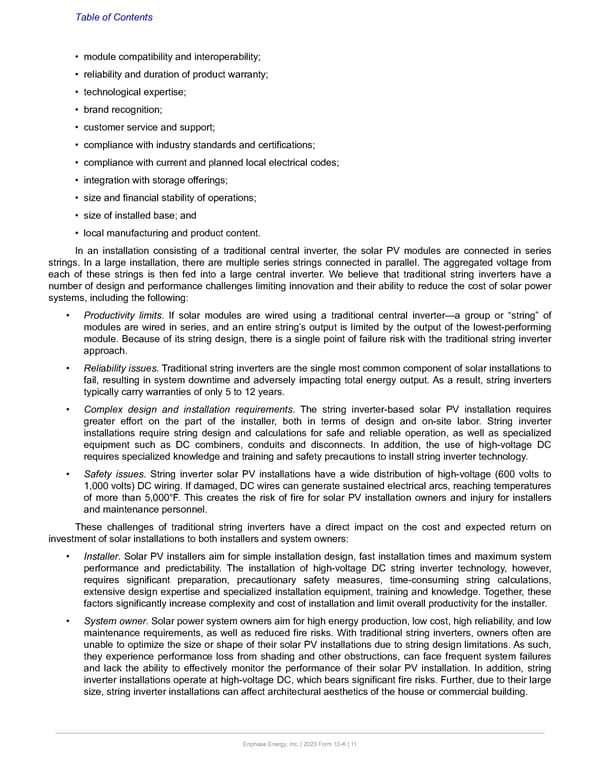Table of Contents • module compatibility and interoperability; • reliability and duration of product warranty; • technological expertise; • brand recognition; • customer service and support; • compliance with industry standards and certifications; • compliance with current and planned local electrical codes; • integration with storage offerings; • size and financial stability of operations; • size of installed base; and • local manufacturing and product content. In an installation consisting of a traditional central inverter, the solar PV modules are connected in series strings. In a large installation, there are multiple series strings connected in parallel. The aggregated voltage from each of these strings is then fed into a large central inverter. We believe that traditional string inverters have a number of design and performance challenges limiting innovation and their ability to reduce the cost of solar power systems, including the following: • Productivity limits. If solar modules are wired using a traditional central inverter—a group or “string” of modules are wired in series, and an entire string’s output is limited by the output of the lowest-performing module. Because of its string design, there is a single point of failure risk with the traditional string inverter approach. • Reliability issues. Traditional string inverters are the single most common component of solar installations to fail, resulting in system downtime and adversely impacting total energy output. As a result, string inverters typically carry warranties of only 5 to 12 years. • Complex design and installation requirements. The string inverter-based solar PV installation requires greater effort on the part of the installer, both in terms of design and on-site labor. String inverter installations require string design and calculations for safe and reliable operation, as well as specialized equipment such as DC combiners, conduits and disconnects. In addition, the use of high-voltage DC requires specialized knowledge and training and safety precautions to install string inverter technology. • Safety issues. String inverter solar PV installations have a wide distribution of high-voltage (600 volts to 1,000 volts) DC wiring. If damaged, DC wires can generate sustained electrical arcs, reaching temperatures of more than 5,000°F. This creates the risk of fire for solar PV installation owners and injury for installers and maintenance personnel. These challenges of traditional string inverters have a direct impact on the cost and expected return on investment of solar installations to both installers and system owners: • Installer. Solar PV installers aim for simple installation design, fast installation times and maximum system performance and predictability. The installation of high-voltage DC string inverter technology, however, requires significant preparation, precautionary safety measures, time-consuming string calculations, extensive design expertise and specialized installation equipment, training and knowledge. Together, these factors significantly increase complexity and cost of installation and limit overall productivity for the installer. • System owner. Solar power system owners aim for high energy production, low cost, high reliability, and low maintenance requirements, as well as reduced fire risks. With traditional string inverters, owners often are unable to optimize the size or shape of their solar PV installations due to string design limitations. As such, they experience performance loss from shading and other obstructions, can face frequent system failures and lack the ability to effectively monitor the performance of their solar PV installation. In addition, string inverter installations operate at high-voltage DC, which bears significant fire risks. Further, due to their large size, string inverter installations can affect architectural aesthetics of the house or commercial building. Enphase Energy, Inc. | 2023 Form 10-K | 11
 Annual Report Page 10 Page 12
Annual Report Page 10 Page 12